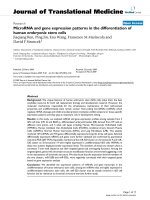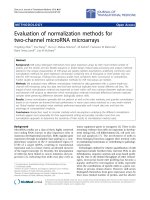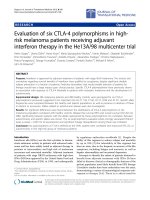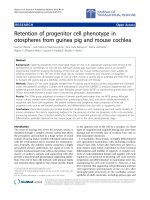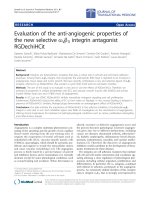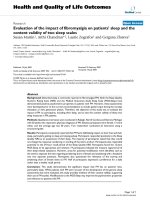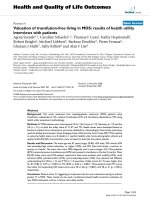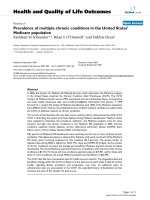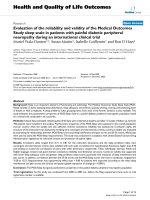Báo cáo hóa học: "Evaluation of six CTLA-4 polymorphisms in highrisk melanoma patients receiving adjuvant interferon therapy in the He13A/98 multicenter trial" docx
Bạn đang xem bản rút gọn của tài liệu. Xem và tải ngay bản đầy đủ của tài liệu tại đây (716.62 KB, 9 trang )
RESEARC H Open Access
Evaluation of six CTLA-4 polymorphisms in high-
risk melanoma patients receiving adjuvant
interferon therapy in t he He13A/98 multicenter trial
Helen Gogas
1*
, Urania Dafni
2
, Henry Koon
3
, Maria Spyropoulou-Vlachou
4
, Yannis Metaxas
1
, Elizabeth Buchbinder
5
,
Eirini Pectasides
1
, Dimosthenis Tsoutsos
6
, Aristidis Polyzos
1
, Alexandros Stratigos
7
, Christos Markopoulos
1
,
Petros Panagiotou
6
, George Fountzilas
8
, Ourania Castana
9
, Pantelis Skarlos
10
, Michael B Atkins
5
,
John M Kirkwood
11
ABSTRACT
Purpose: Interferon is approved for adjuvant treatment of patients with stage IIb/III melanoma. The toxicity and
uncertainty regarding survival benefits of interferon have qualified its acceptance, despite significant durable
relapse prevention in a fraction of patients. Predictive biomarkers that would enable selection of patients for
therapy would have a large impact upon clinical practice. Specific CTLA-4 polymorphisms have previously shown
an association with response to CTLA-4 blockade in patients with metastatic melanoma and the development of
autoimmunity.
Experimental design: 286 melanoma patients and 288 healthy controls were genotyped for six CTLA-4
polymorphisms previously suggested to be important (AG 49, CT 318, CT 60, JO 27, JO30 and JO 31). Specific allele
frequencies were compared between the healthy and patient populations, as well as presence or absence of these
in relation to recurrence. Alleles related to autoimmune disease were also investigated.
Results: No significant differences were found between the distributions of CTLA-4 polymorphisms in the
melanoma population compared with healthy controls. Relapse free survival (RFS) and overall survival (OS) did not
differ significantly between patients with the alleles represented by these polymorphisms. No correlation between
autoimmunity and specific alleles was shown. The six polymorp hisms evaluated where strongly associated (Fisher’s
exact p-values < 0.001 for all associations) and significant linkage disequilibrium among these was indicated.
Conclusion: No polymorphisms of CTLA-4 defined by the SNPs studied were correlated with improved RFS, OS, or
autoimmunity in this high-risk group of melanoma patients.
Introduction
Interferon alfa (IFNa) was the first cytok ine to demon-
strate antitumor activity in patients with advanced mela-
noma and has been widel y tested as adjuvant therapy in
patients at intermediate and high risk of melanoma
recurrence and associated mortality. Adjuvant treatment
of patients with stage IIB/III melanoma with high-dose
IFNa (HDI)was approved by the United States Food and
Drug Administration (FDA) in 1995, and subsequently
by regulatory authorities worldwide [1]. Despite the
ability of this regimen to reduce relapse and mortality
by up to 33% [2] the tolerability of this regimen has
been an issue , due t o the frequent occurrence of flu-like
symptoms, including fa tigue and anorexia, as well as
hepatic abnormalities and occasional depression.
Attempts to identify the subset of patients destined to
benefitfromadjuvanttreatmentwithIFNa -2b have
failed to discover clinical or demographic features of the
patient population most likely benefit from HDI therapy
Correlative studies have been undertaken over the years,
demonstrating a variety of immunological responses sub-
sequent to the rapy [3,4]. There is a critical n eed for
* Correspondence:
1
First Department of Medicine, University of Athens, Medical School, Athens,
Greece
Full list of author information is available at the end of the article
Gogas et al. Journal of Translational Medicine 2010, 8:108
/>© 2010 Gogas et al; licensee BioMed Central Ltd. This is an Open Access article distributed under the terms of the Creative Commons
Attribution License ( censes/by/2.0), which permits unrestricted use, distribution, and reprodu ction in
any medium, provided the original work is properly cited.
great er understandi ng of the immu nological and disease-
related variables that predict clinical benefit from IFNa-
2b. The identification of predictive markers would permit
selection of patients likely to benefit and would enable
the 66% of patients unlikely to benefit to avoid the atten-
dant toxicity. The immunotherapies that benefit
advanced melanoma include IL-2, which has also been
shown to induce autoimmune reactions, thyroiditis, and
vitiligo. [5-14], A variety of autoimmune phenomena
have been reported to occur during adjuvant therapy
withHDI.Inasubstudyofalargerandomizedtrialof
HDI in pat ients with stage IIB/III melanoma, 26% of 200
patients developed antithyroid antibodies or other auto-
immune manifestations [15]. The appearance of autoanti-
bodies or clinical manifestations of autoimmunity was
associated with significant improvements in relapse-free
(RFS) and overall survival (OS) (p < .001). This suggested
that the induction of autoimmunity could be a surrogate
marker for interferon efficacy. However, as autoimmunity
was observed only after a median of three months –and
in some instances, more than a year f rom the start of
IFNa-2b therapy, the development of autoimmunity per
se could not serve as a cri terion for select ing patients to
initiate therapy.
The hum an CTLA-4 gene is locate d o n chromosome
2q33, in a region that is as sociated with su scept ibility for
autoimmune disease [16]. Multiple polymorphisms within
the CTLA-4 g ene have been foun d to be associated with
susceptibility to autoimmune diseases (e.g., the GG allele
of the +49 AG polymorphism is associated with decreased
expression of CTLA-4 upon T-cell activation and thus a
higher proliferation of T -cells) [17-20]. Additionally, in a
phase I study of 19 patients receiving anti-CTLA-4 mono-
clonal antibody with multiple melanoma peptides and
Montanide ISA 51, three of four (75%) patients with t he
CTLA-4 allele JO 30 (GG) developed autoimmune symp-
toms, and only two (50%) experienced disease relapse. Of
the remaining 15 patients expressing either the AA or AG
alleles, only fiv e (33%) dev eloped au toimmune symptoms
and 10 (67%) experienced disease relapse [21].
We therefore eva luated si x CTLA-4 Single Nucleotide
Polymorphisms (SNPs) in a c ohort of high-risk mela-
noma patients enrolled in a study of two regimens of
HDI, and c ompared the dis tribution of these SNPS to
those found in healthy controls (healthy unrelated indivi-
duals from the Donor Marrow Registry of the National
Tissue Typing Center, Athens, Greece). The correlation
of the CTLA-4 polymorphisms associated with the devel-
opment of autoimmune diseases and the HLA Cw*06
allele which pred isposes to psoriasis was also studied as a
consequence of ou r observation that this allele was asso-
ciated with the disease outcome and induction of autoim-
munity in patients treated with adjuvant HDI [22].
Materials and Methods
Materials
We genotyped DNA isolated from the peripheral blood
of a total of 286 patients with melanoma and a panel of
288 randomly selected healthy unrelated Greek indivi-
duals that served as a control population, for 6 CTLA4-
SNPs,namelyCT60,AG49,CT318,JO27,JO30
and JO 31. CT 318 is located within the promoter
region of the CTLA-4 gene, A/G49 is located at exon 1,
while the rest of the SNPs tested are located at the 3’
untranslated region of CTLA-4.
Patients participati ng in this study were enrolled in
Trial 13A/98, a prospective, multicenter, randomized
phase III trial conducted at 13 institutions by the Helle-
nic Cooperative Oncology G roup (HeCOG). This trial,
enrolled 364 patients with histologically documented
AJCC stage IIB, IIC, or III primary cutaneous melanoma
between 1998 and 2004. For patients with clinically unin-
volved lymph nodes, stage was defined pathologically
using sentinel lymph node (SLN) biopsy. Any patient
with a positiv e SLN w as required to undergo completion
lymphadenectomy. All patients were assigned at random
to receive one of t he two t reatment regimens within
2 months of initial surgery or 1.5 months of therapeutic
lymph node dissection. The regimens used were a modi-
fication of the E1684 regimen [23]. Group A patients
received IFN-a2b (15 MIU/m
2
/day IV 5 days per week
for 4 weeks) followed b y observation. Group B patients
received the same induction dose for 4 weeks followed by
subcutaneous therapy (10 MIU/day TIW) f or an addi-
tional 48 weeks. The primary endpoints for the core pro-
tocol were RFS and OS by treatment group.
The CTLA-4 polymorphism sub-study reported here
was conducted retrospectively in four institutions that had
participated in the core protocol. This substudy had sepa-
rate IRB a pproval, and all patients had provided written
informed consent for provision of biological material for
such future resear ch studies at initiation of treatment.
Blood samples for evaluation of CTLA-4 were drawn prior
to treatment at the same time as samples for routine initial
visit blood tests. The first 10 mL of blood collected was
used for standard biochemistry and blood cell counts, and
the second 3 mL was used for CTLA-4 testing.
The clinical outcome of patients was prospectively fol-
lowed using standardized testing. Clinical staging c on-
sisted of medical history, physical exams, blood cell
counts, blood biochemistry at 3-month intervals, and
chest x-ray and liver ultrasound at 6-month intervals.
Methods
DNA was isolated using the GenoPrep extraction sys-
tem (GenoVision, Oslo, Norway) and the SNP-PCR
was carried out with the following primers: CT 318
Gogas et al. Journal of Translational Medicine 2010, 8:108
/>Page 2 of 9
forward ACCCTTGTACTCCAGGAAATTCTC, reverse
biotinylated-GGTTTAGCTGTTACGTCGAAAAGA,
AG 49 forward TTTCAGCGGCACAAGGCTC, reverse
biotinylated-GAGTGCAGGGCCAGGTCC, CT 60 for-
ward GCAAGTCATTCTTGGAAGGTATC, reverse
biotinylated-TGCCAATTGATTTATAAAGGACTG,
JO 27 forward GAGCTGGTCAGCCGAGAT, reverse
biotinylated- TGACACCACCCCTCCAT AAT, JO 30
forward CAAA GCAAAACGCTGCCAATAA, reverse
biotinylated- TCCAGTGGCAATAGGAGCTTTC, JO
31 forward TTGTCATGTTAGCCGTGCAGC, reverse
biotinylated- CCACCACCACACCCAGGTAA. 50 ng of
DNA were amplified in a 50 μL reaction containing 25
μL MasterMix (Illustra HotStart MasterMix, GE Health-
care, Buckinghamshire, UK) 1 μL (10 pmol) of each pri-
mer and denaturized water. PCR conditions were as
follows: first, a 5 minute incubation at 95°C was per-
formed, followed by 45 cycles of a 15 seconds denatura-
tion step at 95°C, 30 seconds annealing step at 56°C and
15 seconds extension step at 72°C. There was a final
extension step at 72°C for 5 minutes. We then geno-
typed the amplicons u sing Pyrosequencing technology
(Biotage, Uppsala, Sweden). The PCR strand which was
labeled by the biotinylated primer was captured on
Streptavidin Sepharose™ High Performance beads (GE
Healthcare, Uppsala, Sweden) and washe d for 1 0 sec-
onds in 70% ethanol to remove PCR residuals. Single-
stranded DNAs were prepared after denaturation for 10
seconds with Denaturati on Solution (Biotage, Uppsa la,
Sweden) and then they were treated for 5 seconds with
appropriate Washing Buffer (Biotage, Uppsala, Sweden).
Hybridization of sequencing primers to respective tem-
plates was carried out according to the standard proto-
col described by the manufacturer (Biotage, Uppsala,
Sweden). All of the sequencing reactions were per-
formed on the PyroMark™ ID pyrosequencer, using the
PSQ 96 SNP Reagent Kit (Biotage AB) and analysis was
done with PyroMark™ ID 1.0 software. The sequencing
primers used were: 318C/T CACTTAGTTATCCA-
GATCCT, AG 49 GCTCAGCTGAACCTG, CT 60 TCA
CCACTATTTGGGATAT, JO 27 TACCAGAAGTT
GAAGTGTAG, JO 30 TCTGTCAGCAAAGCC, and JO
31 ACCTCTTGAGGTCAGGAGT i.
nlm.nih.gov/index.html.en.
Statistical Analysis
Allele frequencies were defined as follows: Each indivi-
dual was used as a unit and a part icular allele was noted
as present if detected in an individual. Specific allele fre-
quencies were calculated both for the patient population
and the healthy control population. Fisher’s exact test
was used for comparing the frequency of specific alleles
(one observation per patient) between t he healthy and
patient populations as well as the frequency of
recurrence between the population where the specific
allele was present versus the population it was absent.
In addition, recurrence and specific allele frequencies
were compared between patients with and without auto-
immuneresponsesaswellasHLA-Cw*06Survivalwas
evaluated from the date protocol treatment was started
to the date of last follow-up or date of death from any
cause. RFS was calculated from the initiation of treat-
ment to the date on which relapse was first documented
or on which death without documented relapse occurred.
The Kaplan-Meier method was used for the estimation of
RFS and OS curves. The reverse censoring method was
used for calculating descriptive statistics for the follow-
up time [24].
Cox regression analyses on RFS and OS were per-
formed, evaluating the association of outcome to the
presence of poly morphisms of CTLA-4 (AG 49, CT 60,
CT 318, JO 27, JO 30, JO 31), as well as of the most fre-
quent haplotypes. The combined effects of HLA-Cw*06,
AG 49 and the presence of autoimmunity on RFS and
OS were explored through a multivariate Cox model.
Maximum likelihood estimates of haplotype frequen-
cies given a multilocus sample of ge netic marker geno-
types [3 different genotypesofthe6polymorphisms]
were generated using the expectation-maximization
(EM) algorithm under the assumption of Hardy-Wein-
berg equilibrium (HWE). Linkage disequilibrium was
explored for each pair of the 6 polymorphisms (PROC
HAPLOTYPE). SAS 9.1 (SAS Institute Inc., Cary, NC,
USA), was used for the statistical analysis.
Results
The frequency patterns of CTLA-4 alleles were first
evaluated in the healthy control and melanoma popula-
tions. There were no statistical differences in the inci-
dence of CTLA-4 p olymorphisms between melanoma
patients and healthy contro ls (Table 1), except for JO
31, where the T/T allele was higher in controls (33.3%
vs 24.3%) while G/G and G/T was lower (p = 0.047).
Patient demographics and baseline characteristics have
been described elsewhere [15,23]. With a median follow
up of 70.7 months [only among patients alive (censored
values), range 7.1-138.7 months], there were 158 recur-
rences (median RFS 55 months, range 1 to 115 months)
and 105 deaths (median OS not reached yet, range 2 to
86 months).
RFS and OS did not differ significantly between
patients with the alleles represented by these po ly-
morphisms. Τhe corresponding p-values for RFS and OS
are presented in Table 2 and Figures 1,2,3,4,5,6. In addi-
tion, RFS and OS did not differ significantly in the
cohort of patients with AG 49 GG when compared with
patients with AG49 AA or AG (p = 0.5 and p = 0.51
respectively). No differences were again demonstrated
Gogas et al. Journal of Translational Medicine 2010, 8:108
/>Page 3 of 9
when CT 318 CC and CT 60 GG where3 compared
with the cohort of patients either heterozygo us or
homozygous to the protective allele (p = 0.38 and p =
0.58, and p = 0.92 and p = 0.38 respectively).
High association between the different polymorphisms
was found (Fisher’s exact p-value < 0.001 for all associa-
tions). Genotypes corresponding to the six CTLA-4
polymorphisms did not significantly deviate from
the Hardy-Weinberg equilibrium. The test indicates
significant linkage disequilibrium among the six
polymorphisms
We analyzed the segregation pattern of CT 318, AG
49, CT 60, JO 27, JO 30, JO 31 SNPs on 572 chromo-
somes and identified 5 major haplotypes (table 3). No
statistically significant differences for RFS or OS were
found for the presence of each of the 3 most common
haplotypes.
The association of Cw*06 with the CTLA-4 alleles was
investigated and a statistically significant association was
found with AG 49 (p = 0.023). In patients with positive
Cw*06, 61.8% w ere AG 49 AA, 29.1% were AG 49 AG
and 9.1% were AG 49 GG. The median relapse-free sur-
vival for Cw*06 positive patients with genotype AG 49
AG was 76.4 months and has not been reached yet for
genotypes AA and GG. In Cw*06 negative patients the
median relapse-free survival for genotypes AG49 AA,
AG and GG was 56 .7, 36.2 a nd 24.6 respe ctivel y. Med-
ian overall survival has not been reached yet i n Cw*06
positive patients in all three genotypes (AG 49 AA, AG,
GG) and in the Cw*06 negative cohort it was 86. 1, 66.7
and 61.2 months, respectively. However, no statistically
sig nificant differences were found for HLA Cw*06 posi-
tive patients in terms of RFS or OS, among AG 49
groups (p = 0.62 and p = 0.46 respectively). Likewise, no
statistically significant differe nces were f ound for HLA
Cw*06 negative patients in terms of RFS and OS among
A/G 49 groups (p = 0.42 and p = 0.39 respectively). RFS
and OS did not differ significantly in the cohort of
patients with AG 49 GG vs AG/AA positive for HLA
Cw*06 (p = 0.37 and p = 0.23 respectively) or negative
for HLA Cw*06 (p = 0.22 and p = 0. 22 respect ively). In
the coho rt of patients included in the prospective auto-
immune study, CTLA-4 polymorphisms were investi-
gated in 157 out of 200 patients (48 autoimmunity
group and 109 without evidence of autoimmunity). No
statistically significant associatio n was found among any
of the six polymorphisms investigated. In the multivari-
ate Cox model for RFS and OS, HLA Cw*06 and auto-
immunity were statistically significantly correlated with
RFS (p = 0.043 and p < 0.001 respectively), while only
autoimmunity was found to be statistically significant
for OS (p = 0.001).
Discussion
This study analyzed the potential influences of the
CTLA-4 genotype upon the outcome of IFN adjuvant
therapy, on the basis of prior suggestions of the role of
certain polymorphisms of the CTLA-4 gene and other
immunotherapies for patients with melanoma. To
answer these questions it was first necessar y to define a
baseline population for comparison. No database was
available that describes the prevalence of CTLA-4 alleles
among the Greek population, nor of melanoma pati ents
from Greece. Severa l groups ha ve reported analyses of
the CTLA-4 genotypes of Caucasian and Japanese popu-
lations, yielding differing results [19,25,26]. Our results
in the healthy Greek control population are similar to
the allele frequencies identified in a population of 536
healthy Spanish haemopoietic stem cell donors that
evaluated the association of CTLA-4 polymorphisms of
patients and the post transplant outcome [ 27]. No sig-
nificant differences were seen among the CTLA-4 pro-
files of the Greek healthy control and melanoma
populations studied here.
Table 1 Frequencies of CTLA-4 polymorphisms in
melanoma patients and healthy controls
Controls Melanomas
Number (N = 288) % Number (N = 286) % P
AG 49
A/A 152 52.8 132 46.2 0.27
A/G 111 38.5 128 44.8
G/G 25 8.7 26 9.1
CT 318
C/C 230 79.9 229 80.1 0.94
C/T 57 19.8 55 19.2
T/T 1 0.4 2 0.7
CT 60
A/A 90 31.3 65 22.7 0.071
A/G 135 46.9 151 52.8
G/G 63 21.9 70 24.5
JO 27
C/C 90 31.3 73 25.5 0.32
C/T 143 49.7 153 53.5
T/T 55 19.1 60 21.0
JO 30
A/A 95 33.0 72 25.2 0.12
A/G 138 47.9 151 52.8
G/G 55 19.1 63 22.0
JO 31
T/T 96 33.3 71 24.8 0.047
G/T 144 50.0 151 52.8
G/G 48 16.8 64 22.4
Gogas et al. Journal of Translational Medicine 2010, 8:108
/>Page 4 of 9
Specific genetic polymorphisms of the CTLA-4 have
been linked with an increased risk for multiple autoim-
mune diseases [17-19,25,26]. Intriguingly, a CTLA-4
polymorphism conferring low-level expression was
found t o be associated with higher frequencies of auto-
immune toxicity among 19 melanoma patients treated
concurrently with MDX-010 (ipilimumab) anti-CTLA-4
monoclonal antibody and a melanoma peptide vaccine
[21]. An important result of this trial was the suggestion
that the incidence of tumor relapse might be reduced
among patients manifesting autoimmune toxicity. An
earlier trial of concurrentMDX-010andmelanoma
peptide vaccination also raised this possibility [28,29].
These provocative findings stimulated detailed investiga-
tion of the polymorphisms of CTLA-4 in larger numbers
of patients treated in a subsequent study of 152 stage IV
melanoma patients at the NIH. These in vestigators eval-
uated 7 common nucleotide polymorphisms and showed
three SNPs to be associated with response to anti-
CTLA4 antibody therapy: -1660AG, -657TC and AG 49.
A haplotype analysis including the same 7 SNPs sug-
gested that the common haplotype TACCGGG was
associated with non-response (p = 0.02) whereas the
haplotype TGCCAGG was associated with response to
Table 2 Univariate Cox Regression Models of Relapse-free Survival and Overall Survival
No of events/No of
patients
Median Relapse- free Survival
(months)
P
value
No of events/No of
patients
Median Overall Survival
(months)
P
value
AG 49
A/
A
71/132 59.56 0.55 47/132 NR* 0.55
A/
G
70/128 46.42 47/128 84.20
G/
G
17/26 35.35 11/26 63.38
CT 318
C/
C
122/229 54.67 0.52 82/229 NR 0.36
C/T 34/55 47.67 21/55 NR
T/T 2/2 37.35 2/2 51.02
CT 60
A/
A
34/65 58.87 0.68 23/65 NR 0.64
A/
G
85/151 47.67 54/151 84.20
G/
G
39/70 53.22 28/70 76.68
JO 27
C/
C
37/73 58.87 0.60 26/73 NR 0.76
T/C 84/153 54.67 54/153 84.20
T/T 37/60 37.29 25/60 76.68
JO 30
A/
A
37/72 56.71 0.65 27/72 NR 0.74
G/
A
83/151 54.80 52/151 NR
G/
G
38/63 37.29 26/63 76.68
JO 31
T/T 35/71 72.08 0.37 23/71 NR 0.50
G/
T
85/151 47.67 56/151 80.69
G/
G
38/64 39.43 26/64 76.68
* NR: Not Reached
Gogas et al. Journal of Translational Medicine 2010, 8:108
/>Page 5 of 9
this treatment (p = 0.06). No s ignificant association was
observed among the occurrences of severe autoimmune
reactions (grade III/IV) in patients with either single
SNP or haplotype analyses [30].
The present cohort of patients with high risk melanoma
has shown no correlation of any of the polymorphisms of
CTLA-4 defined by the SNPs st udied and improved RFS
or OS, with adjuvant HDI treatment. Similarly, among 90
patients with stage IIB, IIC and III melanoma treated with
HDI, AG 49 and CT 318 genotypes did not correlate with
improved RFS and OS (Henry Koon, personal communi-
cation). There was a trend t ow ards improved survival in
the group with AG 49 AA (p = 0.06). The A allel e of A G
49 was significantly associated with response (p = 0.009)
among the 152 patients with stage IV melanoma treated
with ipilimumab [30]. In the present study population,
patients with the AG 49 AA allele had a better RFS and
OS, but this did not reach statistical significance. This was
also the case with the CT 60AA allele. The A allele at CT
60 has b een identified as being responsible for a greater
production of the soluble form of CTLA4 (s-CTLA4)
[19,27], reflecting T-cell activation [31,32].
The GG allele was not associated with the development
of autoimmunity in the cohort of pati ents retrospectively
studiedhere.IntheNIHStudy[30]allelefrequencies
were also compared between groups of patients who
developed aut oimmune reaction of grad e III/IV and
those who did n ot–but no significant difference was
observed. These findings may support the hypothesis that
“induced autoimmunity” by IFN, IL-2, CTLA-4 blockade
that is often a reversible process is a different process
from spontaneous autoimmune disease. On the other
hand, independent of genetic variation in CTLA-4, there
was a strong positive association among response to the
treatment and grade III/IV toxicity (p < 0.002) [30], as
previously reported [28, 29], and shown in our previously
published work [15]. Failure to demonstrat e the
Figure 1 RFS plot by A/G 49 status.
Figure 2 OS plot by A/G 49 status.
Figure 3 RFS plot by C/T 318 status.
Figure 4 OS plot by C/T 318 status.
Gogas et al. Journal of Translational Medicine 2010, 8:108
/>Page 6 of 9
associa tion o f thyroid autoimmunity with certain CTL A-
4 polymorphisms might indicate that the IFNa2b-related
induction of autoimmunity in melanoma patients differs
from spontaneously occurring autoimmune disorders
with respect to the genetics of CTLA-4 and presumably,
also in other aspects of this multi-factorial process. Thus,
different routes to the development of a utoimmunity
may be associated with d ifferent sets of genes. Neverthe-
less, it is most interesting that a statistically significant
association was found between HLA-Cw*06 and AG 49
allele distribution (p = 0.023). Although no statistical
ass ociation was found between AG 49 alleles and RFS or
OS, for HLA- Cw*06 positive patients, the ones with the
GG genotype seemed to fair better regarding RFS and
OS. Only one out of five patients had relapsed and all
were alive. These results are limited by the small sample
size and should be further explored in other trials of
IFN-a2b of the US and European cooperative groups.
Our investigation into the association of CLTA-4 poly-
morphisms and the results of interferon therapy in a
population where the occurrence of autoimmunity has
been rigorously prospectively characterized, assumes that
the predominant effect of CTLA-4 polymorphisms is upon
T-cell responsiveness. The CT 60AA alle le is associated
with increased circulating levels of soluble CTLA-4, which
adds another layer of complexity to these studies. Soluble
CTLA-4 binds to CD80/86 and in vitro suppresses prolif-
eration of committed autoreactive T cell clones in a dose-
dependent manner [33]. However its function in vivo is
unclear as s-CTLA-4 expression has been reported to cor-
relate with the occurrence of autoimm unity. This dichot-
omy may reflect the fact that the effect of s-CTLA-4 is
mediated by cells other that T-cells or that the expression
of s-CTLA-4 during T-cell act ivation results in increased
T-cell responsiveness, through inhibition of CTLA-4 liga-
tion with CD80/86. Measurement of the pretreatment pro-
tein levels of s-CTLA-4 may give us more insight into the
association between CTLA-4 polymorphisms and the clin-
ical outcome of IFN therapy among patients receiving
adjuvant interferon therapy or antibody mediated CTLA-4
blockade. These studies are now being planned.
Conflicts of interest
Helen Gogas, Henry Koon, Michael Atkins and John Kirkwood has served as
consultants to Schering Plough and have received honoraria from Schering
Plough
Acknowledgement Section
The authors thank Mrs Anastasia Gotzou for her secretarial assistance and
Mrs Melina Dimou for technical support at the process of DNA extraction.
Role of funding source.
This study was supported by the Hellenic Cooperative Oncology Group and
the National Tissue Typing Center, Athens Greece and Award Number
P50CA121973 from the National Cancer Institute. The data provided by
Henry Koon in the Discussion section were part of a larger study funded by
Harvard Skin Cancer SPORE (NIH P50 CA93683).
Author details
1
First Department of Medicine, University of Athens, Medical School, Athens,
Greece.
2
Laboratory of Biostatistics, University of Athens School of Nursing,
Athens, Greece.
3
University Hospital Case Medical Center, Case
Comprehensive Cancer Center, Cleveland, OH, USA.
4
Department of
Immunology, National Tissue Typing Center, General Hospital of Athens,
Greece.
5
Beth Israel Deaconess Medical Center, Harvard Medical School,
Boston, Massachusetts, USA.
6
Department of Plastic Surgery and
Microsurgery, G. Gennimatas General Hospital of Athens, Greece.
7
Department of Dermatology, University of Athens, “Andreas Sygros”
Hospital, Athens, Greece.
8
Department of Medical Oncology, Papageorgiou
Hospital, Aristotle University of Thessaloniki, School of Medicine, Thessaloniki,
Greece.
9
Department of Plastic Surgery, Evagelismos Hospital, Athens,
Figure 5 RFS plot by C/T 60 status.
Figure 6 OS plot by C/T 60 status.
Table 3 CTLA-4 most frequent haplotypes
AG49 CT60 CT318 JO27 JO30 JO31 Chromosomes
Frequency
(%)
Standard
Error (%)
A A C C A T 46.99 2.089
G G C T G G 29.34 1.91
A G T T G G 9.77 1.24
A G C T G G 6.49 1.031
A G C C A T 2.81 0.69
Gogas et al. Journal of Translational Medicine 2010, 8:108
/>Page 7 of 9
Greece.
10
Hellenic Cooperative Oncology Group, Data Office, Athens, Greece.
11
University of Pittsburgh Cancer Institute, Hillman Cancer Center, Pittsburgh,
Pennsylvania, USA.
Authors’ contributions
HG Conceived the study, participated in its design and coordination and
helped to draft the manuscript, UD Participated in its design and performed
the statistical analysis and helped to draft the manuscript, HK Conceived the
study and helped to draft the manuscript, MSV Supervised the molecular
genetics studies and is responsible for the quality control, YM Carried out
the molecular genetic studies and participated in the sequence alignment,
EB Carried out the molecular genetic studies and participated in the
sequence alignment of the validating study. Collected and assembled the
data, EP Carried out the molecular genetic studies and participated in the
sequence alignment Collected and assembled the data, DT Provided study
material.
AP Provided study material, AS Provided study material, CM Provided study
material.
PP Provided study material, GF Provided study material and administrative
support.
OC Provided study material, PS Participated in the sequence alignment, MBA
Conceived the study and helped to draft the manuscript, JMK Conceived
the study , participated in its design and helped to draft the manuscript.
All the authors read and approved the final manuscript.
Received: 9 September 2010 Accepted: 3 November 2010
Published: 3 November 2010
References
1. Kirkwood JM, Strawderman MH, Ernstoff MS, Borden EC, Blum RH:
Interferon alfa-2b adjuvant therapy of high-risk resected cutaneous
melanoma: the Eastern Cooperative Oncology Group Trial EST 1684. J
Clin Oncol 1996, 14:7-17.
2. Kirkwood JM, Ibrahim JG, Sosman JA, Sondak VK, Agarwala SS, Ernstoff MS,
Rao U: High-dose interferon alfa-2b significantly prolongs relapse-free
and overall survival compared with the GM2 KLH/QS 21 vaccine in
patients with resected stage IIB-III melanoma: results of intergroup trial
E1694/S9512/C509801. J Clin Oncol 2001, 19:2370-80.
3. Kirkwood JM, Richards Th, Zarour HM, Sosman J, Ernstoff M, Whiteside TL,
Ibrahim J, Blum R, Wieand S, Mascari R: Immunomodulatory effects of
high-dose and low-dose interferon a2b in patients with high-risk
resected melanoma. The E2690 laboratory corollary of intergroup
adjuvant trial E 1690. Cancer 2002, 95:1101-1112.
4. Yurkovetsky ZR, Kirkwood JM, Edington HD, Marrangoni AM,
Velikokhatnaya L, Winans MT, Gorelik E, Lokshin AE: Multiplex analysis of
serum cytokines in melanoma patients treated with interferon alpha2b.
Clin Cancer Res 2007, 13(8):2422-8.
5. Atkins MB, Mier JW, Parkinson DP, Gould JA, Berkman EM, Kaplan MM:
Hypothyroidism after treatment with interleukin-2 and lymphokine-
activated killer cells. N Engl J Med 1988, 318:1557-62.
6. Weijl NI, Van Der Harst D, Brand A, Kooy Y, Van Luxemburg S, Schroder J,
Lentjes E, Van Rood JJ, Cleton FJ, Osanto S: Hypothyroidism during
immunotherapy with interleukin-2 is associated with antithyroid
antibodies and response to treatment. J Clin Oncol 1993, 11 :1376-83.
7. Scalzo S, Gengaro A, Boccoli G, Masciulli R, Giannella G, Salvo G, Marolla P,
Carlini P, Massimini G, Holdener EE, et al: Primary hypothyroidism
associated w ith interleukin-2 and interferon alpha-2 therapy of
melanoma and renal carcinoma. Eur J Cancer 1990, 26:1152-6.
8. Krouse RS, Royal RE, Heywood G, Weintraub BD, White DE, Steinberg SM,
Rosenberg SA, Schwartzentruber DJ: Thyroid dysfunction in 281 patients
with metastatic melanoma in renal carcinoma treated with interleukin-2
alone. J Immunother Emphasis Tumor Immunol 1995, 18:272-8.
9. Phan GQ, Attia P, Steinbrg SM, White DE, Rosenberg SA: Factors associated
with response to high-dose interleukin-2 in patients with metastatic
melanoma. J Clin Oncol 2001, 19:3477-82.
10. Becker JC, Winkler B, Klingert S, Bröcker EB: Antiphospholipid syndrome
associated with immunotherapy for patients with melanoma. Cancer
1994, 73 :1621-4.
11. Rosenberg SA, White DE: Vitiligo in patients with melanoma: normal
tissue antigens can be targets for cancer immunotherapy. J Immunother
Emphasis Tumor Immunol 1996, 19:81-4.
12. Nordlund JJ, Kirkwood JM, Forget BM, Milton G, Albert DM, Lerner AB:
Vitiligo in patients with metastatic melanoma: a good prognostic sign. J
Am Acad Dermatol 1983, 9:689-96.
13. Bystryn JC, Rigel D, Friedman RJ, Kopf A: Prognostic significance of
hypopigmentation in malignant melanoma. Arch Dermatol 1987,
123:1053-5.
14. Schallreuter KU, Levenig C, Berger J: Vitiligo and cutaneous melanoma. A
case study. Dermatologica 1991, 183:239-45.
15. Gogas H, Ioannovich J, Dafni U, Stavropoulou-Giokas C, Frangia K,
Tsoutsos D, Panagiotou P, Polyzos A, Papadopoulos O, Stratigos A,
Markopoulos C, Bafaloukos D, Pectasides D, Fountzilas G, Kirkwood JM:
Prognostic significance of autoimmunity during treatment of melanoma
with interferon. N Engl J Med 2006, 354:709-718.
16. Dariavach P, Mattei MG, Golstein P, Lefranc MP: Human Ig superfamily
CTLA-4 gene: chromosomal localization and identity of protein
sequence between murine and human CTLA-4 cytoplasmic domains. Eur
J Immunol 1988, 18:1901-1905.
17. Kristiansen OP, Larsen ZM, Pociot F: CTLA-4 in autoimmune diseases–a
general susceptibility gene to autoimmunity? Genes Immun1 2000, 1:170-84.
18. Thompson CB, Allison JP: The emerging role of CTLA-4 as an immune
attenuator. Immunity 1997, 7(4):445-50.
19. Ueda H, Howsan JMM, Esposito L, Heward J, Snook H, Chamberlain G,
Rainbow DB, Hunter KM, Smith AN, Di Genova G, Herr MH, Dahlman I,
Payne F, Smyth D, Lowe C, Twells RC, Howlett S, Healy B, Nutland S,
Rance HE, Everett V, Smink LJ, Lam AC, Cordell HJ, Walker NM, Bordin C,
Hulme J, Motzo C, Cucca F, Hess JF, Metzker ML, Rogers J, Gregory S,
Allahabadia A, Nithiyananthan R, Tuomilehto-Wolf E, Tuomilehto J,
Bingley P, Gillespie KM, Undlien DE, Rønningen KS, Guja C, Ionescu-
Tîrgovişte C, Savage DA, Maxwell AP, Carson DJ, Patterson CC, Franklyn JA,
Clayton DG, Peterson LB, Wicker LS, Todd JA, Gough SC: Association of the
T-cell regulatory gene CTLA-4 with susceptibility to autoimmune
disease. Nature 2003, 423:506-511.
20. Gough SCL, Walker LSK, Sansom DM: CTLA-4 gene polymorphism and
autoimmunity. Immunological Reviews 2005, 204:102-115.
21. Sanderson K, Scotland R, Lee P, Liu D, Groshen S, Snively J, Sian S, Nichol G,
Davis T, Keler T, Yellin M, Weber J: Autoimmunity in a phase I trial of a
fully human anti-cytotoxic t-lymphocyte antigen-4 monoclonal antibody
with multiple melanoma peptides and montanide ISA 51 for patients
with resected stages III and IV melanoma. J Clin Oncol 2005, 23:741-750.
22. Gogas H, Kirkwood JM, Falk CS, Sondak VK, Tsoutsos D, Stratigos A,
Markopoulos C, Pectasides D, Spyropoulou-Vlachou M: Correlation of
molecular human leukocyte antigen typing and outcome in high-risk
melanoma patients receiving adjuvant interferon. Cancer 2010,
116:4326-33.
23. Pectasides D, Dafni U, Bafaloukos D, Skarlos D, Polyzos A, Tsoutsos D,
Kalofonos H, Fountzilas G, Panagiotou P, Kokkalis G, Papadopoulos O,
Castana O, Papadopoulos S, Stavrinidis E, Vourli G, Ioannovich J, Gogas H:
Randomized phase III study of 1 month versus 1 year of adjuvant high-
dose interferon alfa-2b in patients, with resected high risk melanoma. J
Clin Oncol 2009, 27(6):939-944.
24. Kaplan EL, Meier P: Non parametric estimation from incomplete
observation. J Am Stat Assoc 1958, 53:457-481.
25. Furugaki K, Shirasawa S, Ishikawa N, Ito K, Ito K, Kubota S, Kuma K, Tamai H,
Akamizu T, Hiratani H, Tanaka M, Sasazuki T: Association of the T-cell
regulatory gene CTLA-4 with Graves’ disease and autoimmune thyroid
disease in the Japanese. J Hum Genet 2004,
49:166-168.
26. Ikegami H, Awata T, Kawasaki E, Kobayashi T, Maruyama T, Nakanishi K,
Shimada A, Amemiya S, Kawabata Y, Kurihara S, Tanaka S, Kanazawa Y,
Mochizuki M, Ogihara T: The association of CTLA-4 polymorphism with
type 1 diabetes is concentrated in patients complicated with
autoimmune thyroid disease: a multicenter collaborative study in Japan.
J Clin Endocrinol Metab 2006, 91:1087-1092.
27. Perez-Gardcia A, De la Camara R, Roman-Gomez J: CTLA-4 polymorphisms
and clinical outcome after allogeneic stem cell transplantation from
HLA-identical sibling donors. Blood 2007, 100:461-467.
28. Phan GQ, Yang JC, Sherry RM, Hwu P, Topalian SL, Schwartzentruber DJ,
Restifo NP, Haworth LR, Seipp CA, Freezer LJ, Morton KE, Mavroukakis SA,
Duray PH, Steinberg SM, Allison JP, Davis TA, Rosenberg SA: Cancer
regression and autoimmunity induced by cytotoxic T lymphocyte-
associate antigen 4 blockade in patients with metastatic melanoma. Proc
Natl Acad Sci USA 2003, 100:8372-8377.
Gogas et al. Journal of Translational Medicine 2010, 8:108
/>Page 8 of 9
29. Attia P, Phan GQ, Maker AV, Robinson MR, Quezado MM, Yang JC,
Sherry RM, Topalian SL, Kammula US, Royal RE, Restifo NP, Haworth LR,
Levy C, Mavroukakis SA, Nichol G, Yellin MJ, Rosenberg SA: Autoimmunity
correlates with tumor regression in patients with metastatic melanoma
treated with anti-cytotoxic T-lymphocyte antigen-4. J Clin Oncol 2005,
23:6043-6053.
30. Breunis WB, Tarazona-Santos E, Chen R, Kiley M, Rosenberg SA, Chanock SJ:
Influence of Cytotoxic T lymphocyte-associated antigen 4 (CTLA4)
common polymorphisms on outcome in treatment of melanoma
patients with CTLA-4 blockade. J Immunother 2008, 31:586-590.
31. Oaks MK, Hallett KM: Cutting edge: a soluble form of CTLA-4 in patients
with autoimmune thyroid disease. J Immunol 2000, 164:5015-5018.
32. Liu MF, Wang CR, Chen PC, Fung LL: Increased expression of soluble
cytotoxic T-lymphocyte-associated antigen-4 molecule in patients with
systemic lupus erythematosus. Scan J Immunol 2003, 57:568-572.
33. Huurman VA, Unger WW, Koeleman BP, Oaks MK, Chandraker AK,
Terpstra OT, Roep BO: Differential inhibition of autoreactive memory- and
alloreactive naïve T cell responses by soluble cytotoxic T lymphocyte
antigen 4 (sCTLA4), CTLA4Ig and LEA29Y. Clin Exp Immunol 2007,
150:487-93.
doi:10.1186/1479-5876-8-108
Cite this article as: Gogas et al.: Evaluation of six CTLA-4 polymorphisms
in high-risk melanoma patients receiving adjuvant interferon therapy in
the He13A/98 multicenter trial. Journal of Translational Medicine 2010 8:108.
Submit your next manuscript to BioMed Central
and take full advantage of:
• Convenient online submission
• Thorough peer review
• No space constraints or color figure charges
• Immediate publication on acceptance
• Inclusion in PubMed, CAS, Scopus and Google Scholar
• Research which is freely available for redistribution
Submit your manuscript at
www.biomedcentral.com/submit
Gogas et al. Journal of Translational Medicine 2010, 8:108
/>Page 9 of 9
